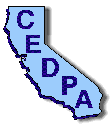
 |
California Educational Data Processing Association |
The DataBus - Vol. 36, No. 4
|
LEMON GROVE--Green lights, red lights, glowing computer monitors, oscilloscopes, wires and cords this way and that. Must be Darryl La Gace's office.
La Gace eyeballs an oscilloscope on a recent morning, a tiny screen showing the heavy amount of microwave radio traffic between schools in this town.
"Just about everybody's doing stuff right now," he says.
Stuff like taking classroom attendance at schools. Stuff like writing e-mail to the White House or assembling flashy multimedia presentations for class.
At a time when school districts countywide have jumped on the computer bandwagon, the 4,300-student Lemon Grove School District has plugged in in a big way.
In fact, some technology experts say the eight-campus district is helping to set the pace for how schools use computers.
"They're among the leaders in innovative technologies in the county," said Skip Sharp, director of information management with the county Office of Education. "They're out leading the parade."
Which brings us back to the manager of the district's computer system, La Gace, and his Lincoln Street office. The small room is chock-full of computer hardware.
The office is the heart of a microwave radio transmission system that provides a two-way computer link between district offices and nearly all classrooms.
In many school districts, classroom computers are often tied to small networks that don't even reach off campus. Some computers aren't even linked to a network.
But the Lemon Grove district has created its own scholastic global village, using microwave radio dishes scattered around the city.
Teachers are using computers equipped with Windows 95 to take daily attendance, shipping the figures to district staff each morning with the stroke of a button.
They also log and track grades for each student, along with class schedules and other information.
Students use the network as a gateway into the Internet, tapping into the treasure trove of resources available on-line. Desktop monitors are linked to CD-ROM software housed in La Gace's office.
"We're teaching skills (the students) can use lifelong in whatever class they are in," said Barbara Allen, principal at Palm Middle School.
District staff and students exchange electronic mail with each other and others, even with the White House, through the centralized microwave system.
On the Palm Middle School campus recently, students enrolled in a computer multimedia class bounced around the Internet, conducting research for their classes.
"It's easier on a computer to do your reports," said 12-year-old Candace Martin, a seventh-grader. "It's faster."
According to Superintendent Joseph Farley, Lemon Grove was the first school district in the nation to install a microwave computer network.
With an initial investment of $162,000, the district bought the microwave system about three years ago, La Gace said. Each school also used grant money, private donations and other funds to purchase desktop computers and to wire classes.
Each campus has a microwave radio dish that transmits and receives data from a 95-foot microwave tower just outside of La Gace's office.
Because the network is centralized, it costs relatively little time and money to maintain, according to district officials.
"It enables us to manage a fairly large network with a small staff," La Gace said. "We're basically getting a lot with very little amount of money."
The technology cuts down on competition among campuses because the same software is made available to all the schools through the microwave network.
The district gets frequent calls from other schools interested in the technology.
County information director Sharp said other East County districts on the leading edge of computer development include Santee School District, Lakeside Union and Grossmont Union High School District.
"Now we have school districts from all over the state that are following our lead on this," said Superintendent Farley. "We get calls from all over the country."